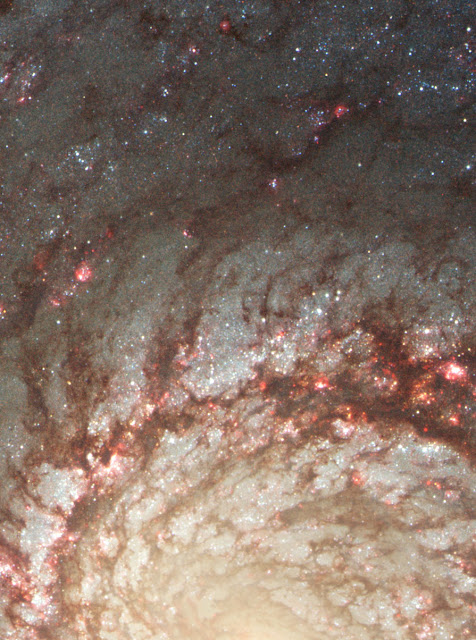The Whirlpool Galaxy is the prototype of a grand-design spiral galaxy seen face-on. It lies with its smaller, yellowish companion in the Canes Venatici constellation, about 31 million light-years away.
 |
| The Whirlpool Galaxy (or M51 or NGC 5194) in all its glory, with the companion galaxy NGC 5195 (top right). Credit: NASA, ESA, S. Beckwith (STScI), and The Hubble Heritage Team STScI/AURA) |
 |
| Hubble optical image of the central region of M51. The region observed is 3 arcminutes (20,000 light-years or 6,000 parsecs) wide. Credit: NASA, ESA, S. Beckwith (STScI), and the Hubble Heritage Team (STScI/AURA) |
The image above, taken in visible light, highlights the attributes of a typical spiral galaxy, including graceful, curving arms, pink star-forming regions, and brilliant blue strands of star clusters. In the image below, most of the starlight has been removed, revealing the Whirlpool's skeletal dust structure, as seen in near-infrared light. This new image is the sharpest view of the dense dust in M51. The narrow lanes of dust revealed by Hubble reflect the galaxy's moniker, the Whirlpool Galaxy, as if they were swirling toward the galaxy's core.
 |
| Hubble NICMOS infrared image of M51. This image, which was obtained by aligning data from both the NICMOS and ACS detectors of the Hubble Space Telescope and dividing the NICMOS brightness values by the ACS values, was originally black and white. These brightness values were translated into a range of reddish hues. Such color "maps" can be useful in helping to distinguish subtly varying brightness in an image. Credit: NASA, ESA, M. Regan and B. Whitmore (STScI), and R. Chandar (University of Toledo) |
The nine images below are full resolution details from the Hubble's optical image of M51. They are ordered clockwise, from top left to bottom right.
Sources:











